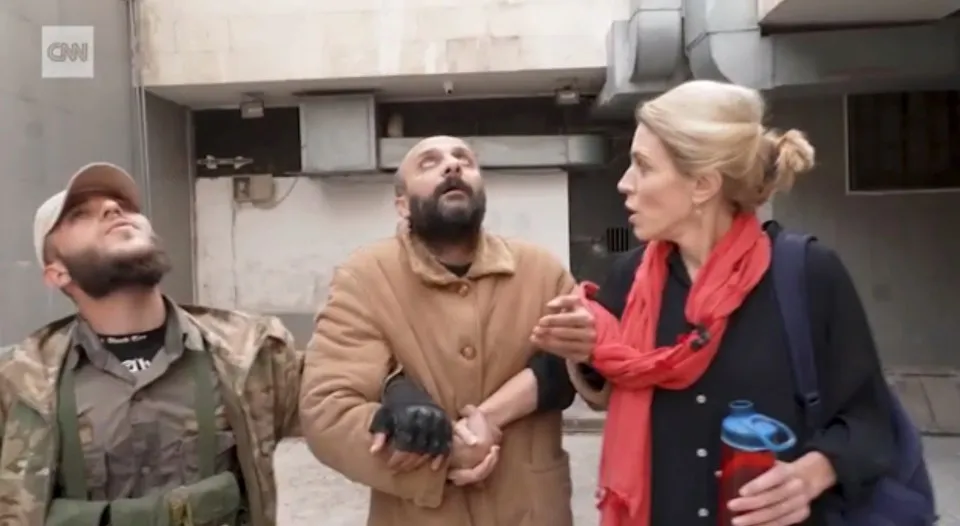A recent CNN broadcast showcasing the dramatic rescue of a Syrian prisoner has sparked controversy, with new allegations suggesting the featured detainee may not have been a victim of the Assad regime as initially portrayed. Instead, critics claim he may have been a former officer in the regime\’s intelligence services, attempting to conceal his identity during the country’s ongoing political upheaval.
The CNN Report
CNN\’s Chief International Correspondent Clarissa Ward, accompanied by her team, reported on the aftermath of the Assad regime’s collapse. During their coverage, they discovered a man crouched under a blanket in a dark, abandoned prison cell. Identifying himself as Adel Gharbal, a father from Homs, the man claimed he had been held in solitary confinement for three months by Assad\’s intelligence services.
In the emotional segment, Gharbal expressed overwhelming relief upon being released, saying, “Oh God, there is light,” as he emerged into the daylight. His story, detailing alleged beatings and isolation, was presented as a testament to the horrors of Assad’s notorious detention system.
Doubts Emerge About the Prisoner’s Identity
Despite the compelling narrative, Verify-Sy, a Syrian fact-checking organization, quickly raised red flags about the man’s story. Observers noted discrepancies in his appearance, which seemed inconsistent with someone who had been subjected to months of torture and neglect. The individual appeared well-groomed, clean, and physically healthy, leading to questions about the authenticity of his claims.
Further investigations by Verify-Sy uncovered information suggesting the man’s true identity might be Salama Mohammad Salama, also known as Abu Hamza, a former first lieutenant in the Syrian Air Force Intelligence. Residents from Homs alleged that Salama had a history of participating in the regime’s oppressive activities, including extortion, theft, and the torture of civilians.
Some locals speculated that Salama staged his imprisonment to gain sympathy and avoid retribution from rebel factions or citizens seeking justice in the aftermath of Assad’s regime collapse.
Implications of the Allegations
If true, the revelation would cast doubt on CNN’s vetting process and highlight the difficulties of reporting in conflict zones where narratives are often manipulated. Salama’s alleged actions, including torture and coercion, would align him with the perpetrators of the regime’s crimes, not its victims.
The story also underscores the complexities of post-conflict environments. As Assad’s regime crumbles, the line between victims and perpetrators is often blurred, with some individuals attempting to rewrite their roles in the conflict. For journalists, distinguishing between genuine accounts and attempts at deception becomes a formidable challenge.
CNN Responds
In response to the controversy, a CNN spokesperson defended the network’s reporting, emphasizing that their footage captured real events as they unfolded. They acknowledged the possibility that the man provided a false identity and confirmed that further investigations into his background are ongoing.
“No one outside of our team was aware of our plans to visit the prison that day,” the spokesperson stated, highlighting the unpredictability of reporting in such volatile situations.
Syria’s Prisons: A Legacy of Horror
The incident has reignited discussions about the Assad regime’s brutal prison system. Thousands of Syrians were detained, tortured, and executed in facilities like the infamous Sednaya Military Prison, dubbed the “Human Slaughterhouse” by Amnesty International.
The fall of Assad’s regime has led to the liberation of many prisons, exposing the atrocities committed within their walls. Survivors and families of victims have shared harrowing accounts of rape, starvation, and execution, providing a grim reminder of the regime’s human rights abuses.
Public and Media Reactions
The controversy surrounding CNN’s report has drawn mixed reactions. Some have defended the network, emphasizing the chaotic nature of reporting in conflict zones. Others have criticized CNN for failing to verify the detainee’s identity before airing his story.
“This case highlights the immense challenges journalists face when covering post-conflict areas,” said media ethics expert Dr. Nadia Khalid. “While the goal is to amplify the voices of victims, it’s crucial to ensure those voices are authentic.”
On social media, reactions have been polarized. Supporters of CNN have praised the team’s courage in reporting from dangerous areas, while critics have accused the network of falling prey to manipulation.
Challenges of Reporting in Conflict Zones
This incident underscores the inherent difficulties of journalism in war-torn regions. With information often unreliable and sources biased by personal or political motives, journalists must navigate a minefield of misinformation while striving to present the truth.
“Post-conflict zones are filled with individuals trying to rewrite their histories,” said political analyst Omar Al-Haj. “For journalists, separating fact from fiction is a monumental task, particularly in a country as fragmented as Syria.”
The allegations surrounding CNN’s Syrian prisoner rescue story highlight the complexities of covering human rights abuses in post-conflict settings. As the truth behind the man’s identity unfolds, the incident serves as a stark reminder of the challenges and responsibilities journalists face in delivering accurate and credible reporting.
For Syria, the fall of Assad’s regime marks the beginning of a long journey toward justice and reconciliation. However, cases like this reveal the hurdles in uncovering the truth amidst a landscape of decades-long oppression and systemic abuse.
Sources
- Viral Syrian \’prisoner\’ found by CNN crew cowering in cell \’was fleeing Assad officer pretending to be regime opponent\’
- CNN criticized over Syrian prisoner rescue narrative
- Post-Assad Syria: The struggle for justice
- The Sednaya Prison atrocities revealed
- Verify-Sy fact-checks Syrian prisoner identity

